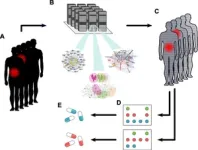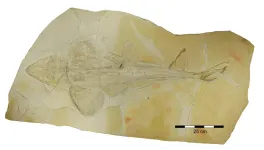(Press-News.org) Researchers from North Carolina State University have taken technology aimed at helping humans suffering from lymphedema – in which the accumulation of excess lymph fluid causes swollen limbs – and developed a medical device to aid horses suffering from the same condition. In a pilot study the device, called the EQ Press, was successful in moving fluid up the limbs and into the lymph nodes. This could lead to relief for horses with chronic conditions, as well as with temporary swelling due to injury or inactivity.
“Across the board, horses are predisposed to lower limb swelling,” says Lauren Schnabel, associate professor of equine orthopedic surgery at NC State and study co-author. “Lymphatic flow is driven by muscle contractions that circulate lymph fluid through the lymphatic system – horses are prone to lymphatic issues because they have very little musculature in the lower limbs.”
The severity of the condition can vary widely – from temporary swelling due to curtailed mobility, to lymphangitis caused by infections that can scar the lymphatic system. Owners will usually treat the condition by wrapping the limbs and icing them while encouraging exercise. But the effects of these treatments are usually only temporary.
“Humans suffer from the exact same type of lymphedema horses do, but the difference is that human medicine has a very effective treatment option – pneumatic compression devices,” Schnabel says. “So we wanted to create a horse-specific version of those devices and see if it would be similarly effective.”
Working closely with a company that manufactures human pneumatic compression devices, Schnabel developed the EQ Press in collaboration with former NC State veterinary student Irina Perdew.
The full EQ Press system comprises custom garments designed to accommodate the front and rear limbs of horses. Powered by pumps that tuck into a saddle pad, the device creates cycles of dynamic pressure waves that start at the bottom of the limb and move up, forcing fluid up the limb and eliminating backflow.
“There was anecdotal data that indicated compression treatment worked well for horses, but we wanted scientific evidence that demonstrates the utility of pneumatic compression for such large animals,” Schnabel says. “So we designed the NC State pilot study.”
In the study, six healthy thoroughbreds were injected with a tracer isotope in their lower front limbs – a harmless sulfur colloid that is taken up and excreted through the lymphatic system. A specialized camera followed the progression of the isotope up the lymphatic system and into a lymph node in the upper limb, a process known as lymphoscintigraphy.
Each horse underwent lymphoscintigraphy twice – once with treatment by the EQ Press on the front limbs and once without – randomized between treatment and control.
In all of the EQ Press treated horses, the camera showed the tracer isotope moving from the lower limb to the lymph node in the upper limb within a 60-minute window. Of the control horses, only one showed that the tracer isotope was able to reach the lymph node.
Overall, EQ Press treated horses had significantly accelerated lymphatic flow compared to untreated horses, recorded as both time to move out of the lower limb and also as time to reach the lymph node in the upper limb.
Schnabel and the research team found the results encouraging and want to determine whether pneumatic compression treatment will be as helpful for horses as it is for humans.
“Now we have compelling evidence that pneumatic compression treatments can accelerate lymphatic flow in healthy horses,” Schnabel says. “Our next step is to study the effectiveness of the EQ Press for treatment of horses with medical conditions such as lymphedema.”
The study appears in the American Journal of Veterinary Research. Drew Koch, postdoctoral fellow at NC State, is corresponding author of the work. Schnabel is co-founder and chief medical officer of Vetletics, Inc., the company that manufactures the EQ Press.
-peake-
Note to editors: An abstract follows.
“Pneumatic compression therapy using the EQ Press accelerates lymphatic flow in healthy equine forelimbs as determined by lymphoscintigraphy”
DOI: doi.org/10.2460/ajvr.22.12.0214
Authors: Drew Koch, Lauren Schnabel, Justin Reynolds, Clifford Berry, North Carolina State University
Published: Online Feb. 21, 2023 in the American Journal of Veterinary Research
Abstract:
OBJECTIVE
Limb lymphedema in horses can be debilitating and painful. Pneumatic compression therapy has shown significant benefits for people suffering from lymphedema. The objective of this study was to determine the effect of a novel, equine-specific pneumatic compression device on the lymphatic flow of healthy horse forelimbs as determined by Tc-99m sulfur colloid lymphoscintigraphy.
ANIMALS
Six healthy Thoroughbreds.
PROCEDURES
In a randomized crossover design, horses underwent bilateral forelimb lymphoscintigraphy following subcutaneous injection of Tc-99m sulfur colloid at the coronary band as untreated control or with pneumatic compression therapy using the EQ Press. Lateral, static images were obtained of the distal limb (time 0 to 60 minutes) and proximal limb (time 30 to 60 minutes) using a standard gamma camera. Lymphatic flow was determined by assigning a score to the time point at which Tc-99m sulfur colloid was first visualized at the level of the accessory carpal bone (1 to 7) in the distal limb and the cubital lymph node (1 to 4) in the proximal limb.
RESULTS
EQ Press treatment led to a significantly faster lymphatic flow of Tc-99m sulfur colloid to the predetermined anatomic locations of the accessory carpal bone (P = .002) in the distal limb and the cubital lymph node (P = .001) in the proximal limb.
CLINICAL RELEVANCE
Pneumatic compression therapy as provided by an equine-specific device encouraged lymphatic flow in healthy, nonedematous equine forelimbs. These data support further study of the EQ Press for pneumatic compression therapy in horses clinically affected by lymphedema and lymphatic drainage disorders.
END
Compression treatment could relieve horses’ painful swollen limbs
2023-02-28
ELSE PRESS RELEASES FROM THIS DATE:
Jurassic shark – Shark from the Jurassic period was already highly evolved
2023-02-28
Cartilaginous fish have changed much more in the course of their evolutionary history than previously believed. Evidence for this thesis has been provided by new fossils of a ray-like shark, Protospinax annectans, which demonstrate that sharks were already highly evolved in the Late Jurassic. This is the result of a recent study by an international research group led by palaeobiologist Patrick L. Jambura from the Department of Palaeontology at the University of Vienna, which was recently published in the journal Diversity.
Cartilaginous fishes (sharks, rays, and ratfish) ...
Flower power: Research highlights the role of ants in forest regeneration
2023-02-28
BINGHAMTON, N.Y. -- Ants play a key role in forest regeneration, according to a new paper from Binghamton University, State University of New York.
Walk through an old growth forest in early spring, and you’ll be dazzled by wildflowers, their jewel-like tones shining from the forest floor.
But in newer forests, spring ephemerals such as trillium, wild ginger, violets and bloodroot are in shorter supply. The reason may lie with some less-flashy forest residents: Aphaenogaster sp., or the woodland ant.
“Not a lot of people have heard of them, but they are ...
StemJournal welcomes new Co-Editor-in-Chief Giorgia Quadrato, PhD
2023-02-28
Amsterdam, NL, February 28, 2023 – StemJournal (STJ), published by IOS Press, is pleased to announce the appointment of new co-Editor-in-Chief, Giorgia Quadrato, PhD, effective immediately. Dr. Quadrato joins co-Editor-in-Chief Niels Geijsen, PhD, and an eminent international editorial board, who are dedicated to the success of the world’s international journal in stem cell research and therapy, and part of IOS Press’ StemHub.
An outstanding scientist and researcher, Giorgia Quadrato, is an Assistant Professor of Stem Cell Biology and Regenerative Medicine at the Keck School of Medicine ...
HIV reservoirs are established earlier than expected
2023-02-28
Montreal, February 28, 2023—For the first time in humans, a research team has shown that, as early as the first days of infection, HIV is able to create reservoirs where it will hide and persist during antiretroviral therapy.
Until now, the scientific community did not know exactly when or how these viral reservoirs—the existence of which is a major obstacle to curing HIV—are established in human beings.
In a study published in the journal Immunity, scientists led by Nicolas Chomont, a researcher at the CHUM Research Centre (CRCHUM) and professor at Université de Montréal, found ...
Social media posts around solar geoengineering ‘spill over’ into conspiracy theories
2023-02-28
Researchers from the University of Cambridge have analysed more than 800,000 tweets and found that negative emotions expressed about geoengineering – the idea that the climate can be altered using technology – can easily fall into conspiracy.
The researchers analysed tweets 2009 and 2021 tagged with #geoengineering. They used a combination of natural language processing, deep learning and network analysis to explore how public emotions, perceptions and attitudes have changed over a 13-year period.
The researchers found that there is a large amount of ‘spillover’ between geoengineering ...
Your gut’s microbiome, on a chip
2023-02-28
WASHINGTON, Feb. 28, 2023 – The gut is one of the most complex organs in the body. Inside, it teems with a diverse microbial population that interacts and cooperates with intestinal cells to digest food and drugs. Disruptions in this microbiome have strong links to a wide spectrum of diseases, such as inflammatory bowel disease, obesity, asthma, and even psychological and behavioral disorders.
Valid models of the gut are therefore immensely useful for understanding its function and associated ailments. In APL Bioengineering, by AIP Publishing, researchers from the University of California, Berkeley and Lawrence Berkeley National ...
Portable breath-based volatile organic compound monitoring for detection of COVID-19
2023-02-28
About The Study: The findings of this diagnostic study with 167 participants suggest that breath analysis has promise for COVID-19 detection. However, similar to rapid antigen testing, the emergence of new variants poses diagnostic challenges. The results of this study warrant additional evaluation on how to overcome these challenges to use breath analysis to improve the diagnosis and care of patients.
Authors: Xudong Fan, Ph.D., and Kevin R. Ward, M.D., of the University of Michigan in Ann Arbor, are the corresponding authors.
To access the embargoed study: Visit our For The Media website ...
Gender, racial, ethnic Inequities among recipients of multiple NIH research project grants
2023-02-28
About The Study: In this study of National Institutes of Health (NIH) investigators from 1991 to 2020, researchers found a growing gap among NIH investigators that created a cohort of highly funded NIH investigators. Importantly, there were persistent gender, ethnic, and racial inequities among this elite class of super principal investigators (investigators receiving three or more research project grants). As the NIH develops critical initiatives and reforms to promote equity among its investigators, consideration of the persistent gender and ethnic and racial gaps in this elite class ...
Study finds 1-in-5 patients at high risk of cardiovascular disease refuse statin therapy
2023-02-28
Heart disease is the leading cause of death worldwide, killing someone in the United States every 34 seconds, according to the Centers for Disease Control and Prevention. A new study by investigators from Brigham and Women’s Hospital, a founding member of the Mass General Brigham healthcare system, conducted the first population-based study on patients’ nonacceptance of statin therapy recommendations.
The study found that in patients at high risk of developing cardiovascular disease, over 20 percent refused to take statin medications. They were particularly ...
Digital twin opens way to effective treatment of inflammatory diseases
2023-02-28
Inflammatory diseases like rheumatoid arthritis have complex disease mechanisms that can differ from patient to patient with the same diagnosis. This means that currently available drugs have little effect on many patients. Using so-called digital twins, researchers at Karolinska Institutet have now obtained a deeper understanding of the “off and on” proteins that control these diseases. The study, which is published in Cell Reports Medicine, can lead to more personalised drug therapies.
Many patients with inflammatory diseases such as rheumatoid arthritis, Crohn’s disease and ulcerative colitis, never feel fully healthy despite being on medication. ...








